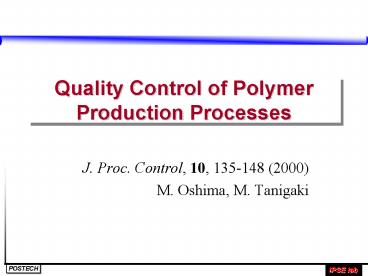Quality Control of Polymer Production Processes - PowerPoint PPT Presentation
1 / 16
Title:
Quality Control of Polymer Production Processes
Description:
Atactic. Distributed. Parameter. MWD. PSD. CCD. High-Order. Structure. Morphology. Molecular Mobility ... An Examples of Three Kinds Model. Mechanistic model ... – PowerPoint PPT presentation
Number of Views:322
Avg rating:3.0/5.0
Title: Quality Control of Polymer Production Processes
1
Quality Control of Polymer Production Processes
- J. Proc. Control, 10, 135-148 (2000)
- M. Oshima, M. Tanigaki
2
Introduction
- Polymer plant operation
- Grade transition
- Maximizing production
- Safe operation of reactor
- Quality control for the objectives
- On-line soft sensing and optimal grade
changeover control
3
Polymer Production Plant
Blender
Monomer
Catalyst
Products
Comonomer
Reactor
Extruder
Separator
4
Prospective Control System
Production Planning
Product Blending Planning
Polymerization Rate Control
Optimal Changeover Operation
Product Quality Control
Concentration Ratio Control
Reaction Temp. Control
Online Property Sensor
Product Blending and Storing Scheduling
Pressure Control
Material Feed Rate Control
Reactor Level Control
Process Monitoring
Polymerization Reactor Control System
Catalyst Processing
Polymerization Reactor
Separation
Extruder
Blending Storing
5
Needs for Quality Modeling
Micro-scale
Macroscale
Residence Time Distribution
ProcessPlant
6
Basic Structure of Inferential System
- Mechanistic model derived from first principles
- Empirical model derived from lab. data
- Black box model by neural nets statistical
methods
7
An Examples of Three Kinds Model
- Mechanistic model (McAuley MacGregor, 1991)
- Empirical model (Watanabe et. al., 1993)
- Neural net model (Koulouris, 1995)
8
MI Estimation by Models
Mechanistic model
Regression model
Neural net model
9
MI Estimation with EKF
Estimation by mechanistic model with EKF
Estimation by regression model with EKF
10
Risk of Extrapolation
Regression model
Neural net model
Mechanistic model
Learning data
11
Grade Changeover Operation
H2
Pattern A
Grade B
Pattern B
Grade A
Grade B
Grade A
Grade A
Grade B
1. Not time but grade optimal operation 2.
Runaway reaction
Instantaneous grade
12
Control System
- Iterative open-loop optimization
- A new optimal trajectory is recomputed
- The first input action is implemented at every
new measurements - Combination of FFFB controllers
- A optimal trajectory is pre-calculated of both
MV CV - MV is introduced to the plant in a FF manner
- CV is deviated from the desired optimal
trajectory, FB controller is activated to
compensate the deviation
13
Results of Control
14
Optimal Blending
Reactor control is not good enough to satisfy the
customers demands
Q(t)
Tank 1
Tank 2
Tank 3
Tank 4
Q44
Q33
Q43
Q21
Q32
Q42
Q21
Q31
Q41
MILP Problem
15
Blending Optimization Result
16
Conclusion
- Integration of process control, sensing and
optimization is indispensable - Most important factor is quality modeling































